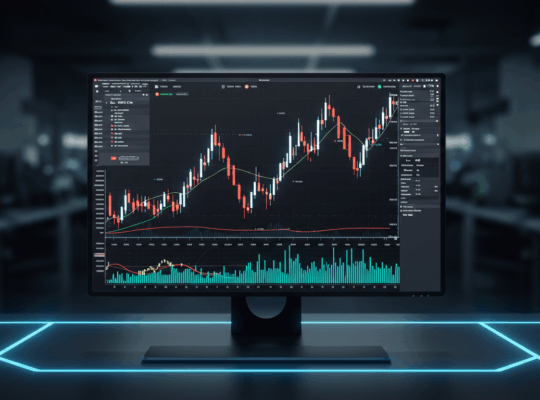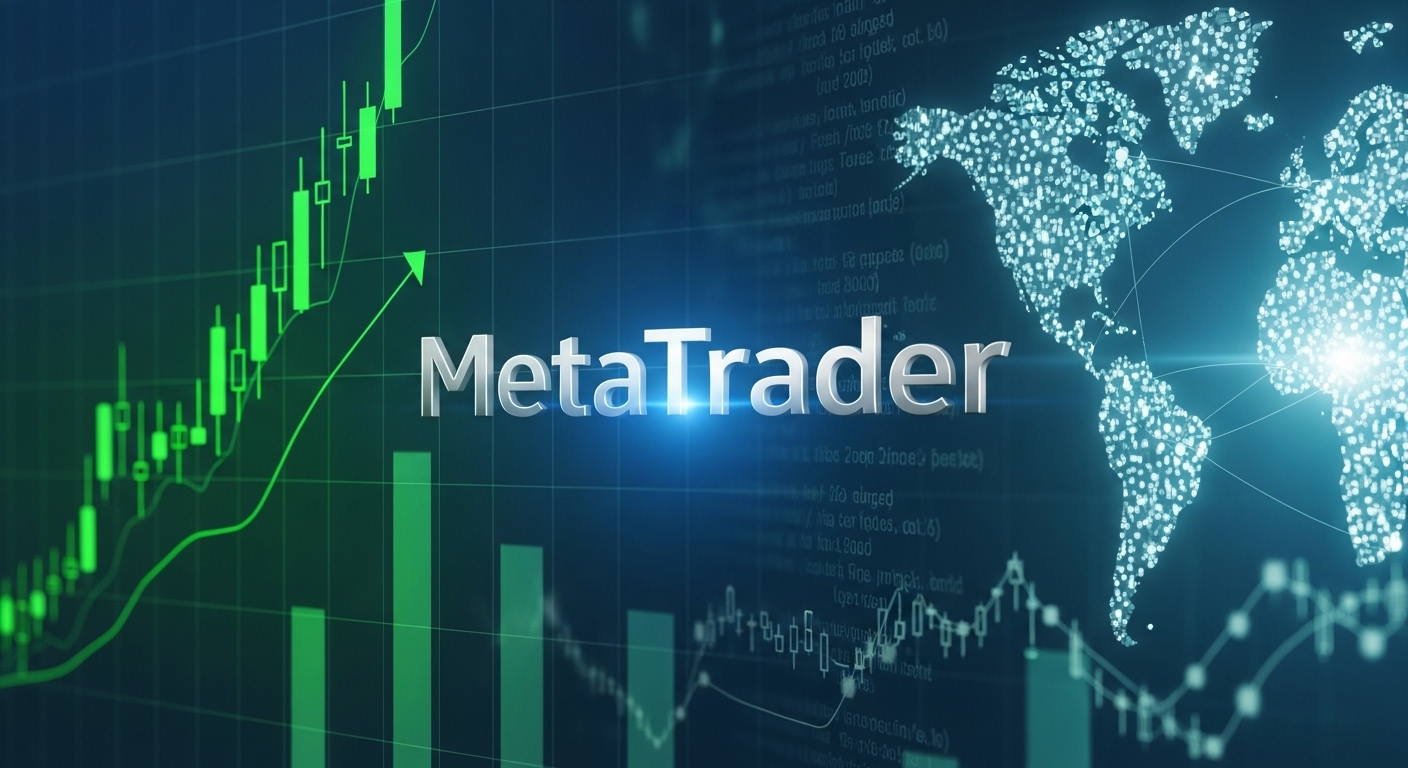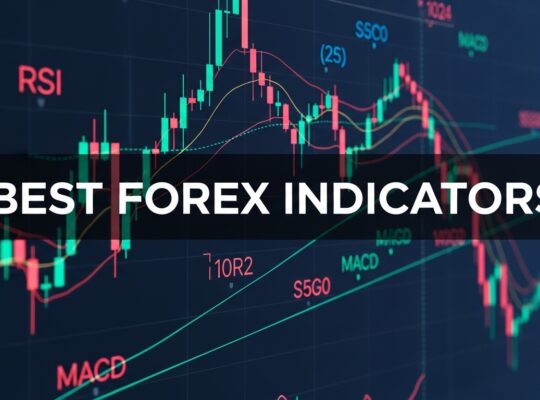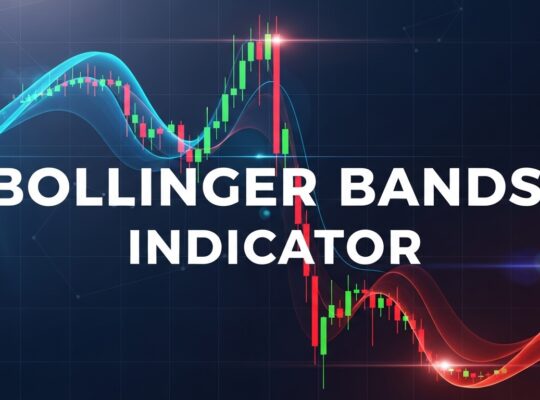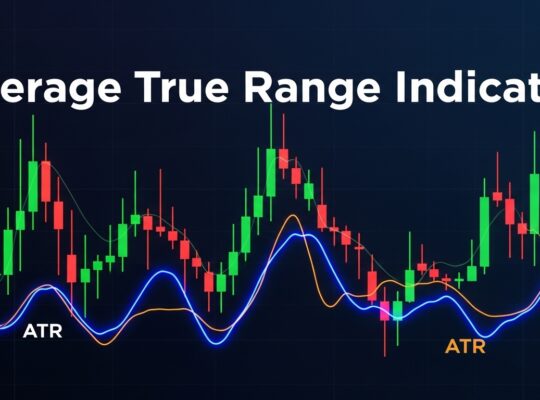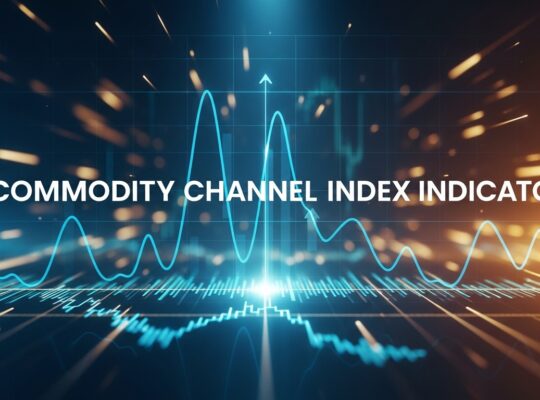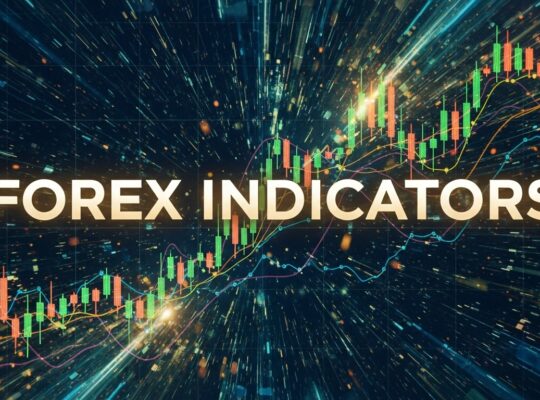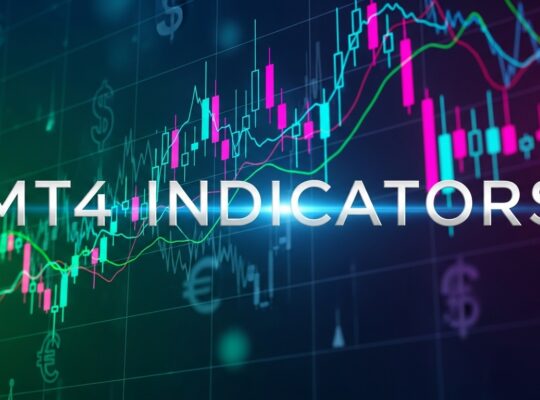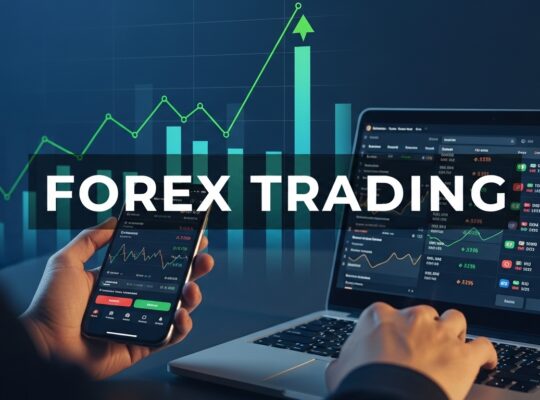If you’ve spent even five minutes researching forex trading platforms, you’ve undoubtedly encountered MetaTrader. But here’s what might surprise you: despite being used by over 750 brokers worldwide and processing millions of trades daily, many traders are only scratching the surface of what this powerful platform can do. Whether you’re a complete beginner wondering which trading platform to choose or an experienced trader looking to maximize your MetaTrader potential, this comprehensive guide will transform how you approach electronic trading.
The forex market moves $7.5 trillion daily, and MetaTrader platforms facilitate a significant portion of that volume. Understanding these platforms isn’t just about learning software—it’s about mastering the tools that could define your trading success. Let’s dive deep into the world of MetaTrader and discover why it has become the gold standard for forex traders globally.
What is MetaTrader?
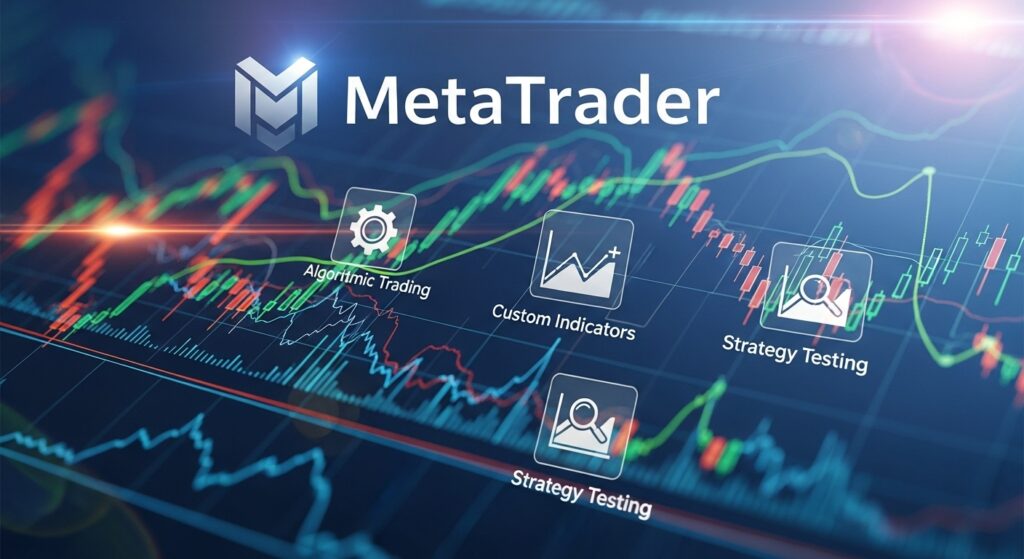
MetaTrader represents the pinnacle of retail trading platform evolution, developed by MetaQuotes Software and first launched in 2005 with MetaTrader 4. Think of it as the Swiss Army knife of trading platforms—versatile, reliable, and packed with features that cater to everyone from day-one beginners to institutional-level professionals.
At its core, MetaTrader is a comprehensive electronic trading platform that connects traders to global financial markets through their chosen brokers. But calling it “just a trading platform” is like calling a Ferrari “just a car.” MetaTrader combines real-time market data, advanced charting capabilities, automated trading systems, and a thriving community marketplace all under one digital roof.
The platform’s dominance isn’t accidental. MetaQuotes Software recognized early that successful trading requires more than just the ability to place buy and sell orders. Traders need sophisticated analysis tools, the ability to automate strategies, access to historical data for backtesting, and the flexibility to customize their trading environment. MetaTrader delivers all of this while maintaining an interface that doesn’t require a computer science degree to navigate.
What truly sets MetaTrader apart is its dual nature. The platform serves both as a gateway to markets and as a complete trading ecosystem. You can analyze markets using dozens of built-in technical indicators, develop and test automated trading strategies, copy trades from successful traders, and even build your own custom trading tools using the platform’s programming languages.
Currently, MetaTrader exists in two primary versions: MetaTrader 4 (MT4) and MetaTrader 5 (MT5). Each version has its strengths, and understanding these differences is crucial for making the right choice for your trading style and goals.
MetaTrader 4: The Veteran Champion
MetaTrader 4 earned its reputation as the world’s most popular forex trading platform through a combination of reliability, simplicity, and powerful features. Despite being nearly two decades old, MT4 continues to dominate the retail forex space, and there are compelling reasons why millions of traders remain loyal to this platform.
The MT4 interface strikes the perfect balance between functionality and usability. When you first open MT4, you’re greeted with four main sections: the Market Watch showing live prices, the Navigator containing your accounts and trading tools, the Terminal displaying your trades and account information, and the chart area where the magic of technical analysis happens. This layout has become so intuitive that most competing platforms adopt similar designs.
MT4’s charting capabilities remain among the best in the industry. The platform offers nine timeframes ranging from one-minute charts for scalpers to monthly charts for long-term position traders. You can overlay more than 30 built-in technical indicators, draw trend lines and support/resistance levels, and save your chart setups as templates for quick access. The charting engine is remarkably responsive, handling multiple charts simultaneously without the lag that plagues some newer platforms.

Perhaps MT4’s greatest strength lies in its Expert Advisor functionality. Expert Advisors, or EAs, are automated trading programs that can execute trades based on predefined criteria without human intervention. This feature democratized algorithmic trading, allowing individual traders to automate strategies that were once exclusive to institutional traders. The MQL4 programming language, while not as advanced as its MQL5 successor, remains accessible enough for ambitious traders to learn and powerful enough to implement sophisticated strategies.
The platform’s stability cannot be overstated. MT4 has been battle-tested through market crashes, flash crashes, and periods of extreme volatility. When your trading capital is on the line, you want a platform that won’t freeze during crucial moments, and MT4 has earned trader confidence through years of reliable performance.
However, MT4 does show its age in certain areas. The platform was designed primarily for forex trading, so its asset coverage is limited compared to modern multi-asset platforms. Additionally, MT4 supports only hedging account types, which can be restrictive for traders who prefer netting systems. The backtesting engine, while functional, lacks the speed and sophistication found in newer platforms.
Despite these limitations, MT4 remains the preferred choice for many professional forex traders. Its extensive community support means you’ll find more third-party indicators, EAs, and educational resources for MT4 than any other platform. If you’re primarily interested in forex and CFD trading and value proven reliability over cutting-edge features, MT4 might be your ideal platform.
MetaTrader 5: The Modern Evolution
MetaTrader 5 represents MetaQuotes’ vision for the future of retail trading, addressing many of MT4’s limitations while introducing features that push the boundaries of what a trading platform can accomplish. Released in 2010, MT5 took several years to gain traction but has steadily grown in popularity as traders recognize its superior capabilities.
The most immediately noticeable improvement in MT5 is its expanded asset coverage. While MT4 focuses primarily on forex and CFDs, MT5 supports stocks, commodities, cryptocurrencies, and futures trading. This multi-asset approach reflects the modern trader’s desire for diversification and the ability to capitalize on opportunities across different markets from a single platform.
MT5’s technical analysis capabilities significantly surpass those of MT4. The platform offers 21 timeframes compared to MT4’s nine, providing more granular analysis options. You’ll find 80+ built-in technical indicators versus MT4’s 30+, and the platform includes advanced order types that give traders more precise control over their entries and exits. The addition of an economic calendar directly integrated into the platform means you can track market-moving news events without leaving your trading environment.
The programming language MQL5 represents a quantum leap forward from MQL4. It’s object-oriented, supports more complex data structures, and enables faster execution of trading algorithms. For traders interested in developing sophisticated automated strategies, MQL5 provides the tools to create institutional-quality trading systems.
One of MT5’s most significant advantages is its improved backtesting engine. The Strategy Tester can utilize multiple processor cores, dramatically reducing the time required to test trading strategies across large datasets. The platform also supports genetic optimization algorithms, helping traders find optimal parameters for their strategies more efficiently.
MT5 introduces the concept of netting alongside hedging, giving traders more flexibility in how they manage positions. The platform’s depth of market (DOM) feature provides transparency into order book data, valuable for traders who use market microstructure analysis in their decision-making process.
The platform also embraces social trading through integration with the MQL5 community. Traders can subscribe to trading signals from successful traders, automatically copying their trades to their own accounts. This feature has made algorithmic and copy trading accessible to traders who lack programming skills or the time to develop their own strategies.
However, MT5 isn’t without its challenges. The platform’s increased complexity can be overwhelming for beginners, and some traders find the interface less intuitive than MT4’s streamlined design. Additionally, not all brokers offer MT5, and the selection of third-party tools and indicators remains smaller than MT4’s extensive ecosystem.
MetaTrader 4 vs MetaTrader 5: Making the Right Choice
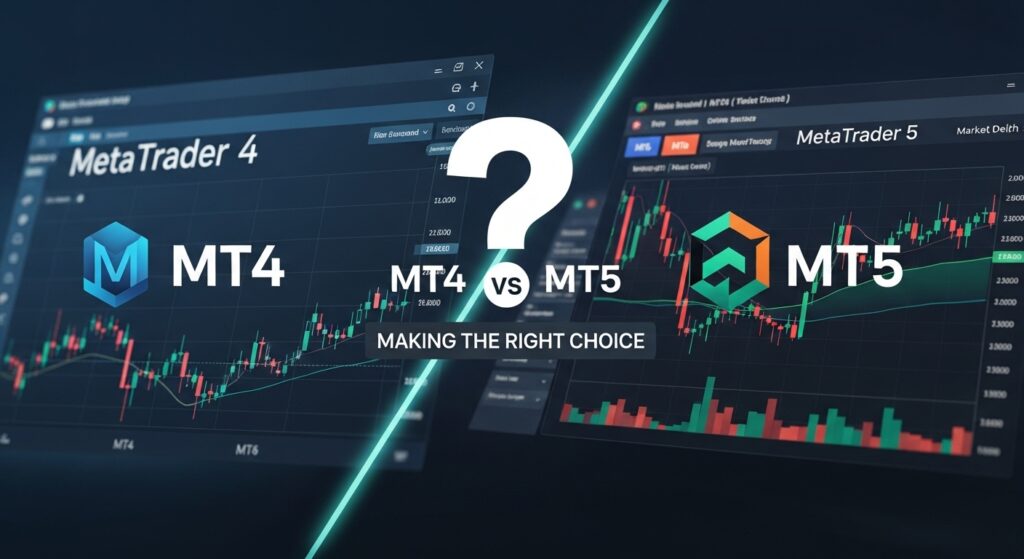
Choosing between MT4 and MT5 often feels like selecting between a beloved classic car and a cutting-edge electric vehicle—both will get you where you want to go, but the journey will feel quite different. The decision ultimately depends on your trading style, goals, and preferences.
MT4 excels in simplicity and specialization. If you’re primarily a forex trader who values straightforward functionality and doesn’t need the latest bells and whistles, MT4 provides everything necessary for successful trading. The platform’s mature ecosystem means you’ll find more educational resources, more third-party tools, and broader broker support. Many institutional and professional traders continue using MT4 because they’ve optimized their workflows around its specific capabilities.
MT5 represents the better choice for traders seeking versatility and advanced features. If you trade multiple asset classes, require sophisticated backtesting capabilities, or want access to the latest trading technologies, MT5 offers clear advantages. The platform’s superior programming language and enhanced technical analysis tools make it particularly attractive to quantitatively-minded traders.
Consider MT4 if you’re new to trading and prefer a gentler learning curve, if you trade exclusively in forex and CFD markets, if you rely heavily on third-party tools and indicators, or if your broker only offers MT4. The platform’s stability and simplicity make it an excellent choice for traders who want to focus on market analysis rather than platform complexity.
Choose MT5 if you trade multiple asset classes or plan to diversify beyond forex, if you’re interested in developing or using advanced automated trading strategies, if you value having the latest features and regular platform updates, or if you’re attracted to social trading and signal copying features. MT5’s forward-thinking design makes it a solid long-term choice as markets and trading technology continue evolving.
Getting Started with MetaTrader
Beginning your MetaTrader journey requires more than simply downloading software—it involves making strategic decisions that will impact your trading experience. The process starts with selecting a reputable broker that offers MetaTrader platforms, as your broker choice affects everything from available trading instruments to execution quality and customer support.
When evaluating MetaTrader brokers, prioritize regulatory compliance first. Regulated brokers must meet strict financial standards and segregate client funds, providing essential protections for your trading capital. Look for brokers regulated by tier-one authorities such as the FCA in the UK, ASIC in Australia, or the CFTC in the United States. These regulators enforce stringent requirements that significantly reduce counterparty risk.
Execution quality represents another critical factor in broker selection. The best MetaTrader brokers offer tight spreads, minimal slippage, and fast execution speeds. Many brokers provide execution statistics or allow you to test their platforms with demo accounts before committing real money. Take advantage of these opportunities to evaluate how well a broker’s MetaTrader implementation performs under various market conditions.
Once you’ve selected a broker, downloading and installing MetaTrader is straightforward. Always download the software directly from your broker’s website or MetaQuotes’ official site to avoid potentially malicious modified versions. The installation process typically takes just a few minutes, and most brokers provide detailed setup guides to help you configure the platform correctly.
Your first login should be to a demo account, even if you’re an experienced trader. Demo accounts allow you to familiarize yourself with the platform’s layout and features without financial risk. Spend time exploring the interface, practicing order placement, and experimenting with different chart setups. This investment in learning pays dividends when you transition to live trading and need to execute decisions quickly and confidently.
Platform customization significantly impacts your trading efficiency. MetaTrader allows extensive personalization, from arranging windows and toolbars to creating custom chart templates and workspaces. Develop a consistent layout that supports your trading style—scalpers might prefer multiple small charts showing different timeframes of the same instrument, while swing traders might focus on fewer charts with more sophisticated analysis tools.
Mastering MetaTrader’s Interface and Navigation
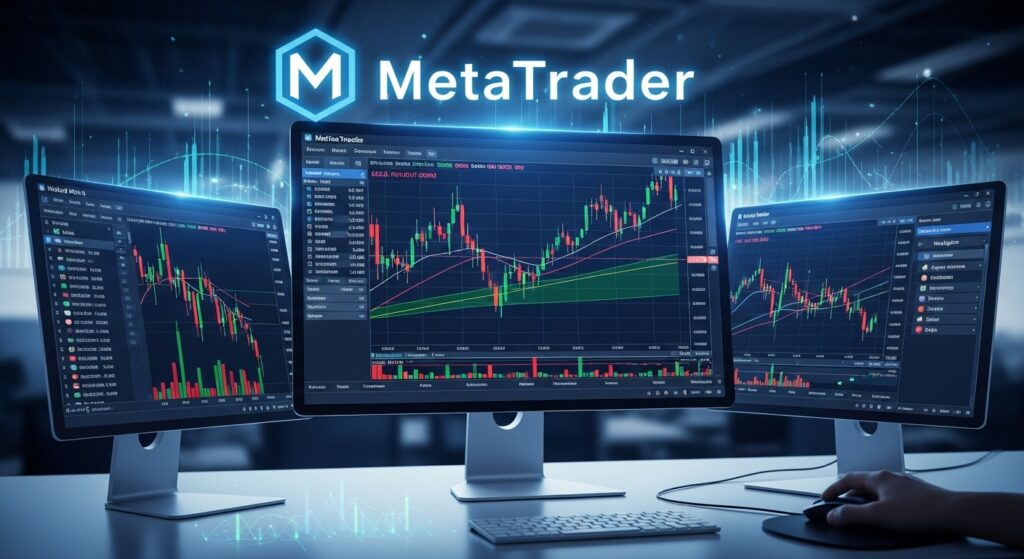
MetaTrader’s interface becomes intuitive once you understand how its components work together to support your trading decisions. Think of the platform as a command center where each window and panel serves a specific purpose in your trading workflow.
The Market Watch window functions as your gateway to available trading instruments. Here you can monitor real-time bid and ask prices, daily ranges, and percentage changes for all instruments your broker offers. Right-clicking on instruments in Market Watch reveals options to open charts, place trades, or view contract specifications. Many traders customize this window to show only the instruments they actively trade, reducing visual clutter and improving focus.
The Navigator panel serves as your MetaTrader toolkit, containing your account information, available indicators, Expert Advisors, and scripts. The Accounts folder shows all your configured trading accounts, allowing quick switching between demo and live accounts or different broker connections. The Indicators folder contains all available technical analysis tools, while the Expert Advisors folder houses your automated trading systems.
The Terminal window provides comprehensive information about your trading activity and account status. The Trade tab displays your current open positions, including profit/loss, swap charges, and other relevant details. The Account History tab shows your complete trading history, essential for performance analysis and tax reporting. The Alerts tab allows you to set price-based or time-based notifications, helping you stay informed about market developments even when you’re away from your computer.
Chart management represents where many traders spend most of their time, and MetaTrader offers powerful tools for customization. You can open multiple charts simultaneously, arrange them in tabs or tile them across your screen, and save specific arrangements as profiles for quick loading. Each chart can display different timeframes and technical indicators, allowing comprehensive multi-timeframe analysis of your preferred instruments.
The drawing tools deserve special attention as they enable precise technical analysis. MetaTrader includes trend lines, horizontal and vertical lines, rectangles, ellipses, and Fibonacci retracement tools. These tools snap to price levels and time coordinates, ensuring accuracy in your analysis. Once drawn, objects can be moved, resized, or modified, and you can save chart templates that include your drawn analysis for future reference.
Understanding order management within the interface is crucial for effective trading. MetaTrader distinguishes between market orders (executed immediately at current prices) and pending orders (executed when price reaches specified levels). The platform supports various pending order types including buy stops, sell stops, buy limits, and sell limits, each serving different strategic purposes.
Technical Analysis Mastery in MetaTrader
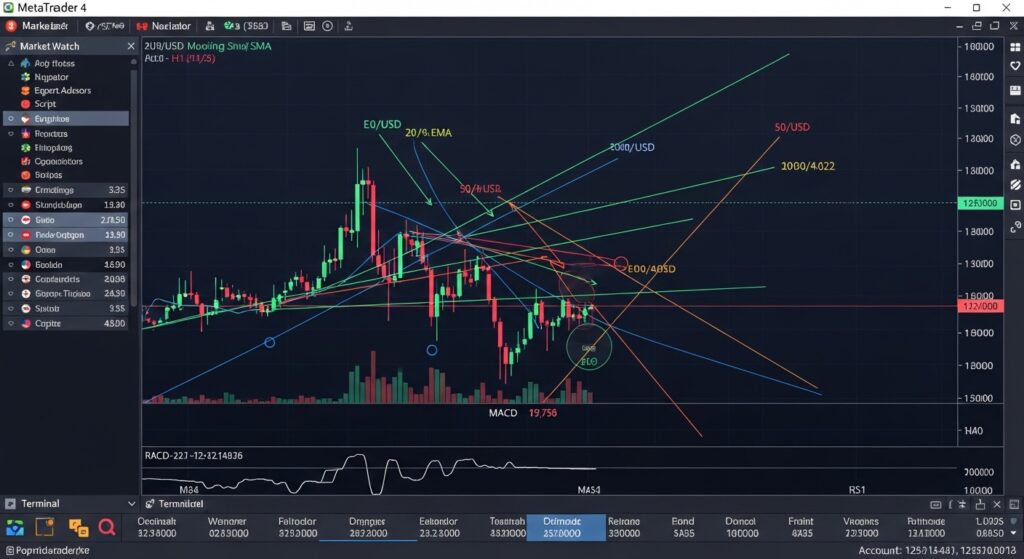
MetaTrader transforms technical analysis from a theoretical concept into a practical trading tool through its comprehensive suite of indicators and analytical features. The platform’s technical analysis capabilities rival those of dedicated charting software while maintaining the integration necessary for seamless trade execution.
The built-in indicators cover every major category of technical analysis. Trend-following indicators like Moving Averages, MACD, and Parabolic SAR help identify market direction and potential reversal points. Oscillators such as RSI, Stochastic, and Williams %R provide insights into momentum and potential overbought or oversold conditions. Volume indicators, though less relevant for forex due to the decentralized nature of the market, become crucial when trading stocks or futures through MT5.
MetaTrader’s indicator implementation goes beyond basic functionality. Most indicators offer extensive customization options, allowing you to adjust parameters, colors, and display styles to match your analytical preferences. You can apply indicators to price data, to other indicators, or to custom data series, creating sophisticated analytical frameworks that would require programming knowledge in other platforms.
The platform’s approach to multiple timeframe analysis deserves particular attention. Professional traders rarely make decisions based on a single timeframe, instead using longer timeframes to identify the overall trend and shorter timeframes for precise entry and exit timing. MetaTrader makes this approach seamless by allowing you to open the same instrument in multiple timeframes simultaneously and by providing indicators that reference higher timeframe data within lower timeframe charts.
Custom indicators expand MetaTrader’s analytical capabilities virtually without limit. The MQL programming languages allow developers to create indicators that perform complex calculations impossible with standard technical analysis tools. Popular custom indicators include advanced pivot point systems, market session indicators for forex traders, and sophisticated trend identification algorithms.
Pattern recognition represents another area where MetaTrader excels. While the platform doesn’t automatically identify chart patterns, its drawing tools and template system allow traders to systematically analyze price patterns. Advanced traders often develop libraries of chart templates configured for specific pattern analysis, enabling quick identification of setup types across multiple instruments.
The platform’s alert system integrates beautifully with technical analysis. You can set alerts based on price levels, indicator values, or custom conditions. This functionality allows you to monitor multiple instruments and timeframes without being glued to your computer screen, receiving notifications only when your predefined conditions are met.
Automated Trading with Expert Advisors

Expert Advisors represent MetaTrader’s most revolutionary feature, democratizing algorithmic trading by making it accessible to individual traders. These automated trading systems can analyze markets, make trading decisions, and execute trades without human intervention, operating 24 hours a day with consistency that human traders struggle to maintain.
The concept behind Expert Advisors is elegantly simple: codify your trading strategy into a set of rules that the computer can follow automatically. If you typically buy EUR/USD when the 50-period moving average crosses above the 200-period moving average and the RSI is below 30, an Expert Advisor can monitor these conditions continuously and execute trades whenever the criteria are met.
Successful EA implementation requires understanding both the opportunities and risks involved. Expert Advisors excel at executing predefined strategies consistently, removing emotional decision-making from trading, and monitoring multiple instruments simultaneously. However, they can only be as good as the strategies they implement, and they may struggle to adapt to changing market conditions that human traders might recognize intuitively.
Finding quality Expert Advisors requires careful evaluation. The MetaTrader Market and MQL5 community offer thousands of EAs, but quality varies dramatically. Look for EAs with transparent performance histories, reasonable drawdown levels, and strategies you understand conceptually. Be extremely wary of EAs promising unrealistic returns or those with limited backtesting data.
When implementing an EA, thorough testing is essential before risking real money. MetaTrader’s Strategy Tester allows you to run EAs against historical data, providing insights into how the strategy would have performed in various market conditions. However, remember that past performance doesn’t guarantee future results, and backtesting has limitations including the inability to account for slippage and the assumption of perfect liquidity.
Risk management becomes even more critical when using Expert Advisors because automated systems can execute many trades quickly if something goes wrong. Implement position sizing rules, maximum daily loss limits, and emergency stop mechanisms. Many successful EA users run multiple smaller EAs with different strategies rather than relying on a single system, diversifying their automated trading approach.
The learning curve for creating custom Expert Advisors is steep but rewarding. MQL4 and MQL5 programming languages are specifically designed for trading applications, making them more accessible than general-purpose programming languages for trading-focused tasks. Many traders begin by modifying existing EAs before progressing to developing completely original systems.
Mobile Trading: MetaTrader in Your Pocket
Mobile trading has evolved from a convenient supplement to desktop platforms into a powerful standalone trading solution. MetaTrader’s mobile applications for iOS and Android provide comprehensive functionality that enables serious trading from virtually anywhere with internet access.
The mobile platform maintains the essential features that make MetaTrader popular while adapting the interface for touch-screen use. You can access real-time quotes, advanced charts with technical indicators, complete trade management capabilities, and even Expert Advisor functionality. The synchronization between mobile and desktop platforms ensures that your charts, indicators, and trading preferences remain consistent across devices.
Chart analysis on mobile devices requires adapting your approach to smaller screens and touch-based navigation. The mobile app supports pinch-to-zoom functionality and intuitive gesture controls for navigating charts and adjusting timeframes. While you can’t display as many charts simultaneously as on desktop, the ability to quickly switch between instruments and timeframes maintains analytical effectiveness.
Order management through mobile platforms offers particular advantages for active traders. Push notifications can alert you to price movements, margin calls, or trade executions instantly, enabling rapid response to market developments. The ability to modify stops and limits, close positions, or enter new trades within seconds of receiving an alert can be crucial during volatile market conditions.
Security considerations become paramount when trading on mobile devices. Always use official MetaTrader apps from legitimate app stores, enable device lock screens and app-specific passwords, avoid trading on public WiFi networks, and consider using VPN services for additional security. The convenience of mobile trading shouldn’t compromise the safety of your trading capital.
Many successful traders develop hybrid workflows that leverage both desktop and mobile platforms strategically. They might conduct detailed analysis and strategy development on desktop while using mobile for trade monitoring, quick adjustments, and emergency position management. This approach maximizes the strengths of each platform while maintaining flexibility and responsiveness.
Advanced MetaTrader Features and Strategies
MetaTrader’s advanced features separate casual users from power traders who leverage every available tool to gain competitive advantages. These features often require more technical knowledge but provide capabilities that can significantly enhance trading performance and efficiency.
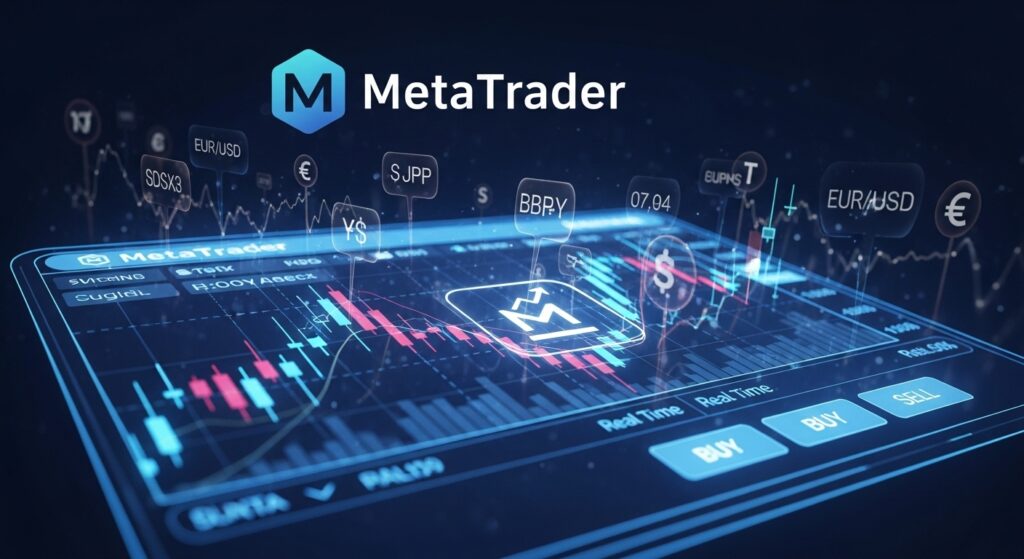
The Strategy Tester represents one of MetaTrader’s most sophisticated features, offering comprehensive backtesting and optimization capabilities. Beyond basic historical testing, the Strategy Tester supports genetic optimization algorithms that systematically test thousands of parameter combinations to identify optimal settings for your trading strategies. This process, which would take humans months to complete manually, can be accomplished in hours with sufficient computing power.
Virtual Private Server integration addresses one of automated trading’s biggest challenges: maintaining constant connectivity. MetaTrader VPS solutions ensure your Expert Advisors continue running even when your personal computer is offline, providing the 24/7 operation that algorithmic trading demands. MetaQuotes offers integrated VPS services directly within the platform, simplifying setup and management.
The MQL5 community features transform MetaTrader into a social trading ecosystem. Signal subscriptions allow you to automatically copy trades from successful traders, while the freelance section connects you with developers who can create custom indicators or Expert Advisors based on your specifications. The community marketplace offers thousands of commercial trading tools, providing access to institutional-quality analysis tools at retail prices.
Advanced charting features include the ability to create custom symbols, import external data, and develop sophisticated multi-instrument analysis systems. Professional traders often create basket instruments that combine multiple currency pairs or develop custom volatility measures that help time entries and exits more precisely.
Portfolio management capabilities in MT5 enable traders to analyze risk and return across multiple positions simultaneously. The platform can calculate portfolio-level statistics, correlation matrices, and risk metrics that inform position sizing and diversification decisions. These features are particularly valuable for traders managing multiple strategies or asset classes.
Security and Risk Management
Trading platform security affects every aspect of your trading business, from protecting login credentials to safeguarding trading capital from technical failures. MetaTrader implements multiple security layers, but traders must also adopt personal security practices to maintain comprehensive protection.
Platform security begins with connection protocols. MetaTrader uses encrypted connections for all data transmission, ensuring that your login information, trading data, and personal details remain protected during transmission. The platform also implements server-side security measures including two-factor authentication options and suspicious activity monitoring.
Personal security practices are equally important. Use strong, unique passwords for your trading accounts and consider password managers to maintain security across multiple platforms. Enable two-factor authentication whenever available, and regularly update your platform software to benefit from the latest security improvements. Be cautious about third-party plugins and indicators, as malicious code could compromise your account security.
Risk management through platform settings can prevent catastrophic losses from technical failures or errors. Set maximum position sizes within the platform, configure automatic stop-loss levels for all trades, and establish daily loss limits that will halt trading if exceeded. Many brokers also offer negative balance protection, ensuring you cannot lose more than your account balance even in extreme market conditions.
Data backup becomes crucial if you’ve customized your platform extensively or developed custom trading tools. Regularly backup your indicator files, Expert Advisors, templates, and configuration settings. MetaTrader allows exporting of these files, making it easy to restore your setup if you need to reinstall the platform or switch computers.
Account monitoring should include regular review of trade confirmations, account statements, and broker communications. Automated trading systems can execute many trades quickly, making regular oversight essential for catching errors or unauthorized activity. Set up account alerts for significant balance changes, margin level warnings, and unusual trading activity.
Common Issues and Troubleshooting
Even the most reliable trading platforms occasionally experience technical issues, and understanding common problems and their solutions can save valuable time and prevent trading disruptions. MetaTrader’s widespread use means that most issues have well-documented solutions.
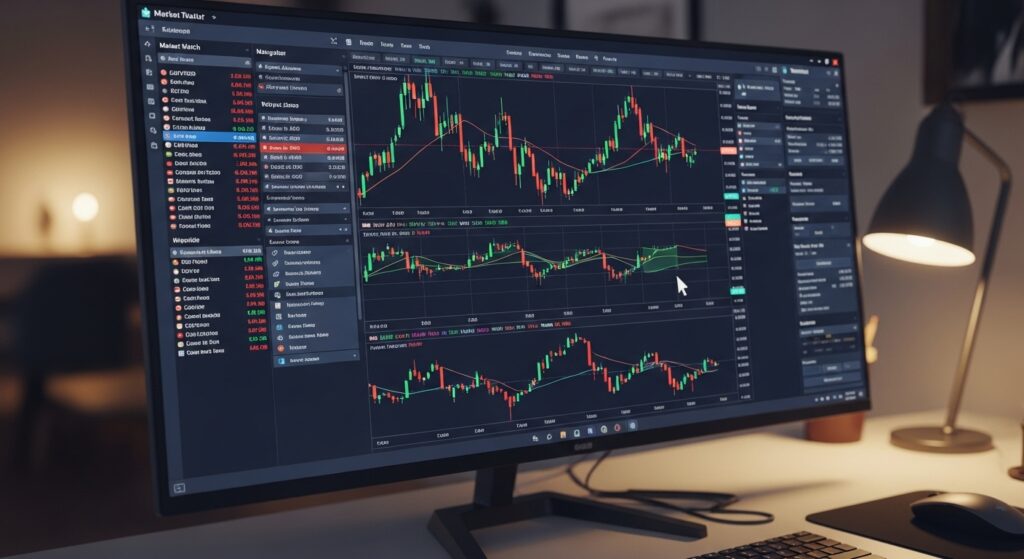
Connection problems represent the most frequent technical issue traders encounter. These can stem from internet connectivity issues, server maintenance, or broker-side problems. When experiencing connection issues, first check your internet connection by accessing other websites or services. If connectivity is fine, try restarting the platform, switching to a different server from your broker’s server list, or contacting broker support for server status updates.
Platform performance issues often relate to resource usage, particularly when running multiple Expert Advisors or displaying numerous charts with complex indicators. Monitor your computer’s CPU and memory usage while running MetaTrader, and consider closing unnecessary charts or EAs if performance degrades. Regular platform updates often include performance improvements that resolve common issues.
Chart display problems can include missing price data, indicator calculation errors, or visual glitches. These often resolve by refreshing the chart data, restarting the platform, or rebuilding the chart from scratch. If problems persist, check with your broker about data feed issues or consider switching to a different price server.
Expert Advisor malfunctions require systematic troubleshooting. Start by checking the EA settings and ensuring all required parameters are configured correctly. Review the MetaEditor journal for error messages that might indicate coding problems or missing resources. If using third-party EAs, verify that you’re using the correct version for your MetaTrader build and that all required libraries are installed.
Order execution problems can be particularly frustrating as they directly impact trading performance. Common issues include “requote” errors, “market closed” messages, or orders that execute at prices significantly different from expected levels. These problems often relate to market conditions, broker liquidity, or incorrect order parameters. Understanding your broker’s execution model and trading conditions helps distinguish between platform issues and normal market behavior.
The Future of MetaTrader Platforms
MetaTrader’s evolution continues as MetaQuotes adapts to changing market structures, regulatory requirements, and trader preferences. Understanding the platform’s development direction helps traders make informed decisions about platform investment and strategy development.
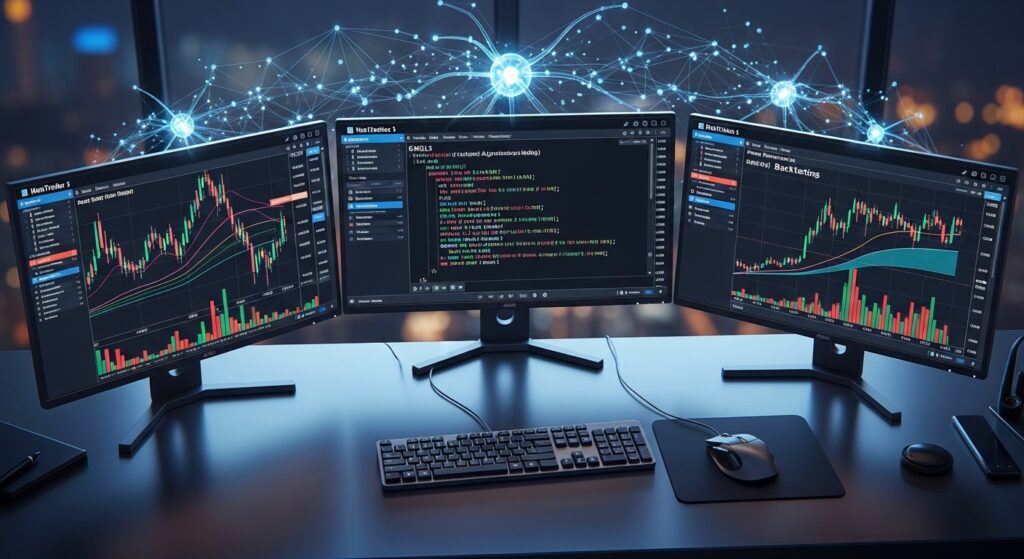
Technological advances drive much of MetaTrader’s development roadmap. Cloud computing integration enables more powerful backtesting and optimization capabilities, while mobile technology improvements bring desktop-level functionality to smartphones and tablets. Artificial intelligence and machine learning integration promise to enhance pattern recognition and strategy development capabilities.
Regulatory changes significantly impact platform development as authorities worldwide implement new requirements for retail trading platforms. Recent regulatory trends toward increased transparency, risk warnings, and client protection measures are reflected in MetaTrader updates that provide enhanced reporting, improved risk management tools, and better disclosure of trading costs and risks.
Market structure evolution also influences platform development. The growth of cryptocurrency trading, increasing retail interest in stock and commodity markets, and the rise of social trading all drive feature development within MetaTrader platforms. MT5’s multi-asset approach positions it well for these trends, while MT4 remains focused on its forex trading strengths.
Competition from newer platforms pushes MetaTrader to innovate while maintaining its core strengths. TradingView’s popularity has influenced MetaTrader’s web-based offerings, while specialized platforms for algorithmic trading have prompted improvements to MQL programming languages and backtesting capabilities.
The platform’s community-driven ecosystem ensures continued relevance as traders and developers contribute indicators, Expert Advisors, and analysis tools that extend functionality beyond what MetaQuotes provides directly. This collaborative approach has proven resilient and adaptable to changing market conditions and trader needs.
Conclusion
MetaTrader’s journey from a specialized forex platform to the world’s most popular retail trading software reflects its fundamental strength: the ability to evolve while maintaining the reliability and functionality that traders depend on. Whether you choose MT4 for its proven simplicity or MT5 for its advanced capabilities, you’re accessing tools that have been refined through years of real-world trading experience.
The platform’s true power lies not just in its individual features but in how those features work together to support your complete trading workflow. From initial market analysis through trade execution and performance evaluation, MetaTrader provides the infrastructure that enables trading success. The extensive customization options mean the platform can adapt to your preferred trading style rather than forcing you to conform to predetermined workflows.
Success with MetaTrader, like success in trading generally, requires commitment to learning and continuous improvement. The platform rewards users who invest time in understanding its capabilities, and the depth of available features means there’s always more to discover. Whether you’re implementing your first Expert Advisor or developing sophisticated multi-timeframe analysis systems, MetaTrader provides the foundation for trading advancement.
The choice between MT4 and MT5 ultimately depends on your specific needs and trading goals, but both platforms offer more than sufficient capability for retail trading success. Start with the platform that matches your current requirements, but remain open to exploring advanced features as your trading sophistication develops.
Ready to begin your MetaTrader journey? Start by opening a demo account with a reputable broker and spending time exploring the platform’s features without financial risk. The investment in learning MetaTrader thoroughly will pay dividends throughout your trading career. Share your MetaTrader experiences in the comments below, and don’t forget to subscribe to our newsletter for more in-depth trading platform guides and market analysis.
Frequently Asked Questions About MetaTrader
What is the main difference between MetaTrader 4 and MetaTrader 5?
The primary differences between MT4 and MT5 lie in their target markets and feature sets. MT4 focuses specifically on forex and CFD trading with a streamlined interface and proven reliability, making it ideal for forex specialists. MT5 offers multi-asset trading capabilities including stocks, commodities, and cryptocurrencies, along with advanced features like more timeframes (21 vs 9), additional technical indicators (80+ vs 30+), and superior backtesting capabilities. MT5 also supports both hedging and netting account types, while MT4 only supports hedging. Choose MT4 if you trade primarily forex and prefer simplicity, or MT5 if you want multi-asset capabilities and advanced features.
Is MetaTrader free to use, and are there any hidden costs?
MetaTrader platforms are completely free to download and use. MetaQuotes provides the software at no cost, and brokers typically offer it without additional charges. However, trading costs still apply through spreads, commissions, and swap fees charged by your broker, not by the MetaTrader platform itself. Some premium features like VPS services or advanced signal subscriptions may have associated costs, but the core platform functionality remains free. Always verify with your chosen broker about their specific fee structure for trading services.
Can I use Expert Advisors on both MT4 and MT5 platforms?
Expert Advisors are platform-specific due to different programming languages. MT4 uses MQL4 while MT5 uses MQL5, making EAs incompatible across platforms. An Expert Advisor developed for MT4 cannot run on MT5 and vice versa, though some developers create versions for both platforms. MT5’s MQL5 language is more advanced and offers better performance, but MT4 has a larger library of available Expert Advisors due to its longer market presence. If you have a specific EA you want to use, verify which platform it supports before making your choice.
How secure is MetaTrader for online trading?
MetaTrader implements robust security measures including 128-bit data encryption for all communications, secure connection protocols, and server-side security monitoring. The platform itself is highly secure, but your overall security depends on additional factors like your broker’s regulatory status, your personal security practices, and your computer’s protection. Use strong passwords, enable two-factor authentication when available, keep your platform updated, and only trade through regulated brokers. Avoid downloading MetaTrader from unofficial sources or installing suspicious third-party plugins that could compromise security.
Can I trade on MetaTrader using my mobile phone effectively?
Yes, MetaTrader’s mobile applications for iOS and Android provide comprehensive trading functionality suitable for serious trading. Mobile versions include real-time charts with technical indicators, complete order management, push notifications for price alerts, and even Expert Advisor support on some versions. While mobile screens limit the number of charts you can view simultaneously compared to desktop, the core analysis and trading capabilities remain robust. Many professional traders successfully manage positions and execute strategies using mobile devices, particularly when combined with desktop analysis for initial setup and detailed market research.




